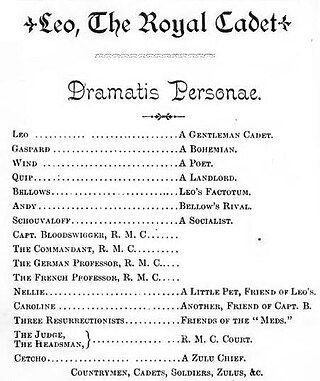Dramatis personae
Main characters in a dramatic work written in a list From Wikipedia, the free encyclopedia
Dramatis personae (Latin: 'persons of the drama') are the main characters in a dramatic work written in a list.[not verified in body] Such lists are commonly employed in various forms of theatre, and also on screen.[not verified in body] Typically, off-stage characters are not considered part of the dramatis personae.[not verified in body] It is said to have been recorded in English since 1730, and is also evident in international use.[1]
This article needs additional citations for verification. (August 2020) |

It is customary to give a cast list, which also has next to each character in a second column the name of the actor or actress playing the part; an alternative version lists the names of the actors who played the parts originally. In order not to give away vital parts of the plot some names may be altered, for example, mixed up with another name. Some minor characters may be listed just as the actors who perform the parts.[not verified in body]
Other uses
In a wider sense, the term can be applied to any situation in which people or characters play a role, or appear to do so—such as a metaphor, a drama, or a court case. It may also be facetiously applied in a situation where members of a group appear to play predictable roles, often for comic effect.[citation needed]
Literary critic Vladimir Propp in his book Morphology of the Folktale uses the term dramatis personae when referring to the character roles of fairy tales, from his analysis of the Russian tales of Alexander Afanasiev.[2]
It is also sometimes used in anthropology to denote the roles people assume when performing a social ritual, as used by Clifford Geertz in his study of Balinese ritual.[3]
Literature
Outside the theatre medium, some novels also have a dramatis personae at the beginning or end. This is most common in books with very large casts of characters, as well as children's books and speculative fiction.[citation needed]
For example, the opening pages of Jon Krakauer's Into Thin Air contain a dramatis personae.
Other examples include Worldwar: In the Balance by Harry Turtledove, and The Horus Heresy by various authors.[citation needed] Tamsyn Muir's Gideon the Ninth begins with a dramatis personae.
Sociology and cultural studies
The term is used to describe the multiple identifications one may adopt in an attempt to emphasize the expression of one's own individualism.[citation needed] An individuality is never obtained, as this process of establishing dramatis personae creates a postmodern persona which 'wears many hats', each different hat worn for a different group or surroundings.[citation needed] A logic of identity and individuality is replaced by a more 'superficial, tactile logic of identification where individuals become more mask-like personae with mutable selves.'[citation needed] This self can no longer be theorized or based solely on an individual's job or productive function.[citation needed] The term was used by Karl Marx throughout Das Kapital, where the capitalist and worker are introduced as dramatis personae in human hinders.
See also
References
Wikiwand - on
Seamless Wikipedia browsing. On steroids.
